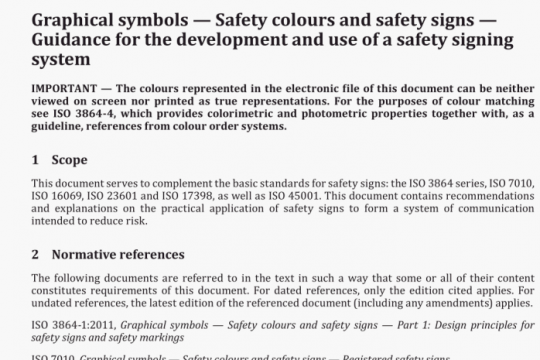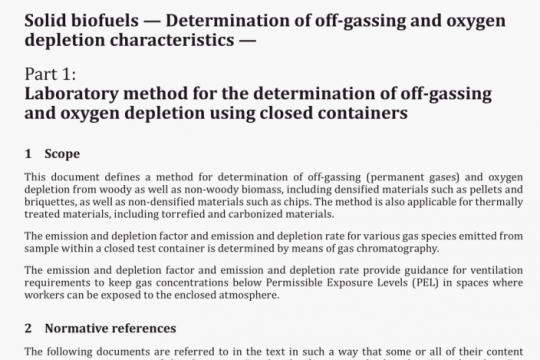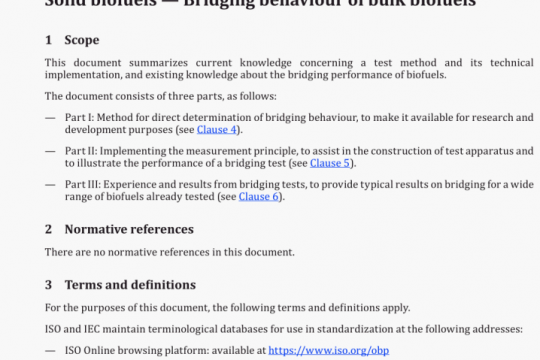ISO 20468-4 pdf free download
ISO 20468-4-2021 pdf free download.Guidelines for performance evaluation of treatment technologies for water reuse systems – Part 4: UV Disinfection.
4 Purpose and function of UV disinfection
4.1 Purpose
To conduct water reuse, secondary or tertiary treated wastewater requires disinfection and sometimes further treatment by more advanced processes. The treated and disinfected wastewater is then used for various applications such as, urban, agricultural, industrial recreational and environmental uses.
4.2 Function
UV light has been proven effective against microorganisms including bacteria, protozoa and viruses (see Annex A). IJV disinfection is achieved mostly by the absorption of photons by the genome of microorganisms, resulting in the formation of damage such as pyrimidine dimers on DNA or RNA. Such lesions hinder the self-replication in the microorganisms and thus deprives the infectivity. Accordingly, liv disinfection does not require chemical addition and results in limited by-product formation.
S System configuration
5.1 General
A UV disinfection system for water reuse can consist of the following components and systems may have several of each component based on the disinfection application requirements.
— UVunit;
— influent water quality monitoring devices;
— flow meter;
— power control panel.
Each component will be explained in 5.2 to 5,5.
5.2 UV unit
A LIV unit has simple components including irradiation chamber, a light source, an automatic cleaning system and a LIV intensity sensor. A specific LIV unit may need one or more LIV intensity sensor and one or more irradiation chamber and light source, depending on the specifics of the application. LIV units may be categorized into closed and open systems, based on the configuration of LIV units in the irradiation chamber. The closed system has a UV unit, comprised of LIV lamps and their sleeves, placed in the closed vessel flow chamber. Meanwhile, the open system has a LIV unit immersed in an open channel or chamber with gravity flow and water level control device. LIV systems can also consist of non-contact unit designs with LIV lamps suspended outside a transparent conduit that carries the wastewater.
— light source
A light source for LIV disinfection should have a germicidal emission at wavelengths appropriate to the task, often at the wavelength of 253,7 nm or a combination of wavelengths between 200-385 nm. Options include low-pressure mercury lamps, medium-pressure mercury lamps, excimer lamps, pulsed-Xenon lamps, and ultraviolet light emitting diodes. The light source should be housed in a lamp protection component.
— cleaning system
A cleaning system is the device having a wiper driven by electric power supply, hydraulic power supply or pressurized air, or ultrasonic wave, etc. Options include a mechanical wiper consisting of a brush, ring or a mechanical chemical wiper consisting of a chamber with rings filled with a washing liquid.
— UV intensity sensor
A LIV intensity sensor is installed to measure the UV irradiance in the irradiation chamber so that the
irradiance can he tracked and it can he determined whether the required dose has been provided.
— ballast
A ballast is installed when using a LIV lamp as a light source. Ballasts provide the power that the lamp converts to UV photons (energy).
5.3 Influent water quality monitoring devices
A UV transmittance monitor can be used to feed data to the system controller to adjust the power of the lamp to assure that the required dose is provided. To check whether or not the water quality of the influent has changed from the design conditions, water quality monitors including a UV transmittance monitor, a turbidity meter (optional) etc. are used.
5.4 Flow meter
Generally, each LIV unit should have a dedicated flow meter for several reasons, including to confirm that the unit is operating within the validated flow rate range. The measured flow rate data may be sent to control panel and may be utilized for light-source controlling, monitoring and operating in order to achieve system performance. The method of flow rate measurement should be selected according to the variability in plant flow rate and installation conditions.
5.5 Power control panel
The control panel has the following functions: power receiving, power supplying, controlling, monitoring and operating, and other functions for the light source and other apparatuses.ISO 20468-4 pdf download.




